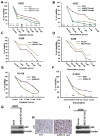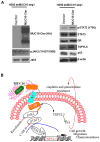MUC16 Regulates TSPYL5 for Lung Cancer Cell Growth and Chemoresistance by Suppressing p53
- PMID: 28196872
- PMCID: PMC5511558
- DOI: 10.1158/1078-0432.CCR-16-2530
MUC16 Regulates TSPYL5 for Lung Cancer Cell Growth and Chemoresistance by Suppressing p53
Abstract
Purpose: MUC16, a tumor biomarker and cell surface-associated mucin, is overexpressed in various cancers; however, its role in lung cancer pathogenesis is unknown. Here, we have explored the mechanistic role of MUC16 in lung cancer.Experimental Design: To identify the functional role of MUC16, stable knockdown was carried in lung cancer cells with two different shRNAs. Clinical significance of MUC16 was evaluated in lung cancer patient tissues using IHC. We have generated genetically engineered mouse model (KrasG12D; AdCre) to evaluate the preclinical significance of MUC16.Results: MUC16 was overexpressed (P = 0.03) in lung cancer as compared with normal tissues. MUC16 knockdown (KD) in lung cancer cell lines decreased the in vitro growth rate (P < 0.05), migration (P < 0.001), and in vivo tumor growth (P = 0.007), whereas overexpression of MUC16-carboxyl terminal (MUC16-Cter) resulted in increased growth rate (P < 0.001). Transcriptome analysis of MUC16 KD showed a downregulation (P = 0.005) of TSPYL5 gene, which encodes for a testis-specific Y-like protein. Rescue studies via overexpression of MUC16-Cter in MUC16 KD cells showed activation of signaling proteins, such as JAK2 (Y1007/1008), STAT3 (Y705), and glucocorticoid receptor (GR), which constitutes an important axis for the regulation of TSPYL5 for oncogenic process. Further, inhibition of STAT3 (Y705) led to decreased GR and TSPYL5, suggesting that MUC16 regulates TSPYL5 through the JAK2/STAT3/GR axis. Also, MUC16 overexpression induced cisplatin and gemcitabine resistance by downregulation of p53.Conclusions: Our findings indicate a significant role of MUC16 in tumorigenesis and metastasis of lung cancer cells possibly via regulation of TSPYL5 through the JAK2/STAT3/GR axis. Clin Cancer Res; 23(14); 3906-17. ©2017 AACR.
©2017 American Association for Cancer Research.
Conflict of interest statement
The authors declare that they have no conflicts of interest.
Figures






Similar articles
-
MUC16 facilitates cervical cancer progression via JAK2/STAT3 phosphorylation-mediated cyclooxygenase-2 expression.Genes Genomics. 2020 Feb;42(2):127-133. doi: 10.1007/s13258-019-00885-9. Epub 2019 Nov 17. Genes Genomics. 2020. PMID: 31736008
-
MUC16 induced rapid G2/M transition via interactions with JAK2 for increased proliferation and anti-apoptosis in breast cancer cells.Oncogene. 2012 Feb 16;31(7):805-17. doi: 10.1038/onc.2011.297. Epub 2011 Jul 25. Oncogene. 2012. PMID: 21785467 Free PMC article.
-
Mucin 16 Promotes Colorectal Cancer Development and Progression Through Activation of Janus Kinase 2.Dig Dis Sci. 2022 Jun;67(6):2195-2208. doi: 10.1007/s10620-021-07004-3. Epub 2021 May 12. Dig Dis Sci. 2022. PMID: 33982216
-
MUC16 as a novel target for cancer therapy.Expert Opin Ther Targets. 2018 Aug;22(8):675-686. doi: 10.1080/14728222.2018.1498845. Epub 2018 Jul 26. Expert Opin Ther Targets. 2018. PMID: 29999426 Free PMC article. Review.
-
MUC16: clinical targets with great potential.Clin Exp Med. 2024 May 17;24(1):101. doi: 10.1007/s10238-024-01365-5. Clin Exp Med. 2024. PMID: 38758220 Free PMC article. Review.
Cited by
-
Overexpression of MUC16 predicts favourable prognosis in MUC16-mutant cervical cancer related to immune response.Exp Ther Med. 2020 Aug;20(2):1725-1733. doi: 10.3892/etm.2020.8836. Epub 2020 Jun 4. Exp Ther Med. 2020. PMID: 32765681 Free PMC article.
-
Identification of basement membrane-related signatures for estimating prognosis, immune infiltration landscape and drug candidates in pancreatic adenocarcinoma.J Cancer. 2024 Jan 1;15(2):401-417. doi: 10.7150/jca.89665. eCollection 2024. J Cancer. 2024. PMID: 38169540 Free PMC article.
-
Effect of MUC16 mutations on tumor mutation burden and its potential prognostic significance for cutaneous melanoma.Am J Transl Res. 2022 Feb 15;14(2):849-862. eCollection 2022. Am J Transl Res. 2022. PMID: 35273689 Free PMC article.
-
The Mechanism of Steroid Hormones in Non-Small Cell Lung Cancer: From Molecular Signaling to Clinical Application.Biomedicines. 2025 Aug 15;13(8):1992. doi: 10.3390/biomedicines13081992. Biomedicines. 2025. PMID: 40868244 Free PMC article. Review.
-
Clinical and Prognostic Value of PPIA, SQSTM1, and CCL20 in Hepatocellular Carcinoma Patients by Single-Cell Transcriptome Analysis.Cells. 2022 Sep 30;11(19):3078. doi: 10.3390/cells11193078. Cells. 2022. PMID: 36231045 Free PMC article.
References
-
- Hollingsworth MA, Swanson BJ. Mucins in cancer: protection and control of the cell surface. Nat Rev Cancer. 2004;4(1):45–60. - PubMed
MeSH terms
Substances
Grants and funding
LinkOut - more resources
Full Text Sources
Other Literature Sources
Medical
Molecular Biology Databases
Research Materials
Miscellaneous

